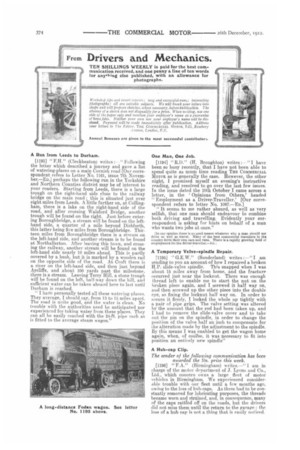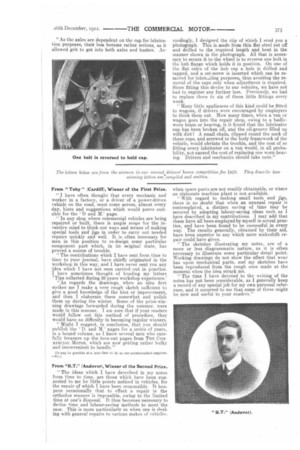Drivers and Mechanics.
Page 18

Page 19

If you've noticed an error in this article please click here to report it so we can fix it.
TEN SHILLINGS WEEKLY is paid for the best communication received, and one penny a line of tenwords or anything else published, with an allowance for photographs.
A Run From Leeds to Durham.
[1193] " F.H." (Cleckheaton) writes :"Following the letter which described a journey and gave a list of watering-places on a, main Cornish road [Our correspondent refers to Letter No. 1161, issue 7th Novemben—En.] perhaps the following run in the Yorkshire and Northern Counties district may be of interest to your readers. Starting from Leeds, there is a large trough on the ritilit-hand side close to the railway bridge on the main road ; this is situated just over eight miles from Leeds. A little further on, at Coilingham, there is a lake on the right-hand side of the road, and after crossing Walsford Bridge, another trough will be found on the right. Just before entering Bopoughbridge, a stream will be found on the lefthand side, a quarter of a mile beyond Dishforth, this latter being five miles from Boroughbridge. Thirteen miles from Boroughbridge there is a stream on the left-hand side, and another stream is to be found at Northallerton. After leaving this town, and crossing the railway, another stream will be found on the left-hand side nearly 10 miles ahead. This is partly covered by a bush) but it is marked by a wooden rail on the opposite side of the road. At Croft there is a river on the left-hand side, and then just beyond Aycliffe, and about 100 yards past the milestone, there is a stream. Leaving Terry Hill, a stone trough will be found on the left, half-way down the hill, and sufficient water can be taken aboard here to last until Durham is reached.
" I have personally tested all these watering places. They average, I should say, from 13 to 15 miles apart. The road is quite good, and the water is clean. No trouble with the authorities need be anticipated nor experienced for taking water from these places. They can all be easily reached with the 24-ft. pipe such RS is fitted to the average steam wagon."
One Man, One Job.
[1194] "R.I.)." (H. Broughton) writes :— "I have been so busy recently, that I have not been able to spend quite as men time reading THE COMMERCIAL MOTOR as is generally the case. However, the other night, I promised myself an evening's instructive reading, and resolved to go over the last few issues. In the issue dated the 10th October I came across a letter, in the ' Opinions from Others,' headed "Employment as a Driver-Traveller.' [Our correspondent refers to letter No. 1087.—ED.] " It seems to me rather absurd, as well as very selfish, that one man should endeavour lo combine both driving and travelling. Evidently your correspondent is asking for hints on behalf of a man who wants two jobs at once."
(In our opinion there is no good reason whatever wit.y a man should not drive as well as travel. many of the beat commercial travellers in the country drive their own cars and vans. There is a rapidly growing field of employment for the driver-traveller.—t.'n.
A Temporary Valve-spindle Repair.
{1195.1 "G.E.W." (Sunderland) writes :—" I am sending to you an account of how I repaired a broken H.P. slide-valve spindle. TMs snapped when I was about 15 miles away from home, and the fracture occurred just near the locknut. There was enough thread left to enable me to start the nut on the broken piece again, and I screwed it half way on, arid then screwed up the other piece into the double eye, so fixing the locknut half way on. In order to secure it firmly, I locked the whole up tightly with a pair of pipe grips. The valve setting was altered by the amount that the rod had been taken up, and I had to remove the slide-valve cover and to take out the pin on the spindle, in order to change the position of the valve half an inch to compensate for the alteration made by the adjustment to the spindle. By this means I was enabled to get the wagon home again, when, a corrise, it was necessary to fit into position an entirely new spindle" A Hub-cap Clip.
The sender of the following communication has been awarded the 10s. prize this week.
[1196] " F.A." (Birmingham) writes." I am in charge of the. motor department of j. Lyons and Co., Ltd., which concern owns a large fleet of motor vehicles in Birmingham. We experienced considerable trouble with our fleet until a few months ago, owing to the loss of hub-caps. As these had to be constantly removed for lubricating purposes, the threads became worn and strained, and, in consequence, many of the caps rattled off on the roads, but. the drivers did not miss them until the return to the garage the loss of a hub cap is not a thing that is easily noticed.
"As the axles are dependent on the cap for lubrication purposes, their lose, became rather serious, as it allowed grit to get into both axles and bushes. Ac
cordingly, I designed the clip of which I send you a photograph. This is made from thin flat steel cut off and drilled to the required length and bent in the manner shown in the photograph. All that is necessary to secure it to the wheel is to reverse one bolt in the hub flange which holds it in position. On one of the flat sides of the hub cap a hole is drilled and tapped, and a set-screw is inserted which can be removed for lubring purposes, thus avoiding the removal of the caps only when adjustinent is required_ Since fitting this device to our vehicles, we have not had to register any further loss. Previously, we had to replace three to six of these little fittings every week.
'Many little appliances of this kind could be fitted to wagons, if drivers were encouraged by employers to think them out. How many times, when a van or wagon goes into the repair shop, owing to a badlyworn brass or bearing, is it found that. the lubricator cup has been broken off, and the oil-groove filled up with dirt? A small chain, clipped round the neck of these cups, and screwed to the body framework of the vehicle, would obviate the trouble, and the cost of so fitting every lubricator on a van would, in all probability, not exceed the cost of replacing one worn bearing. Drivers and mechanics should take note."




















